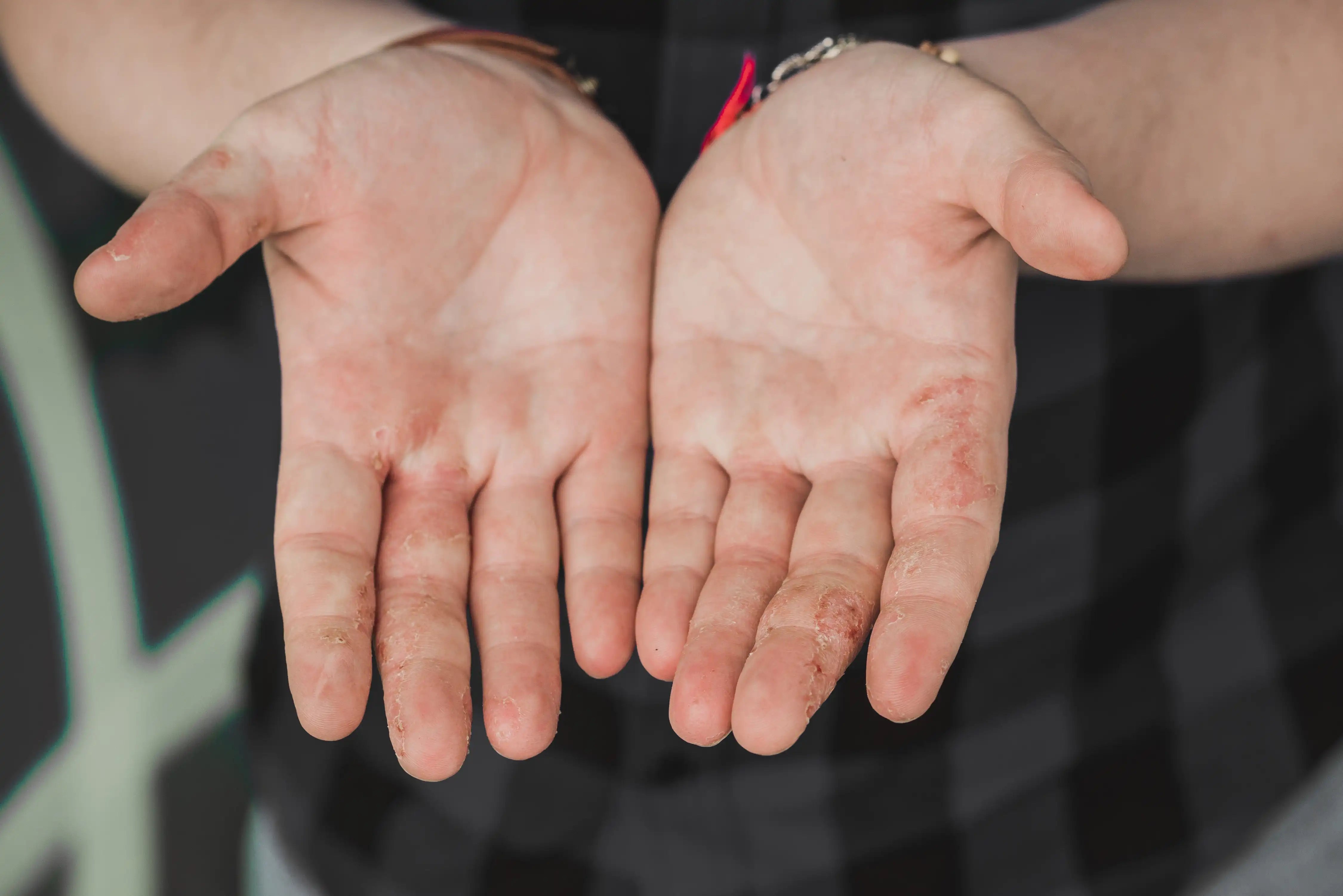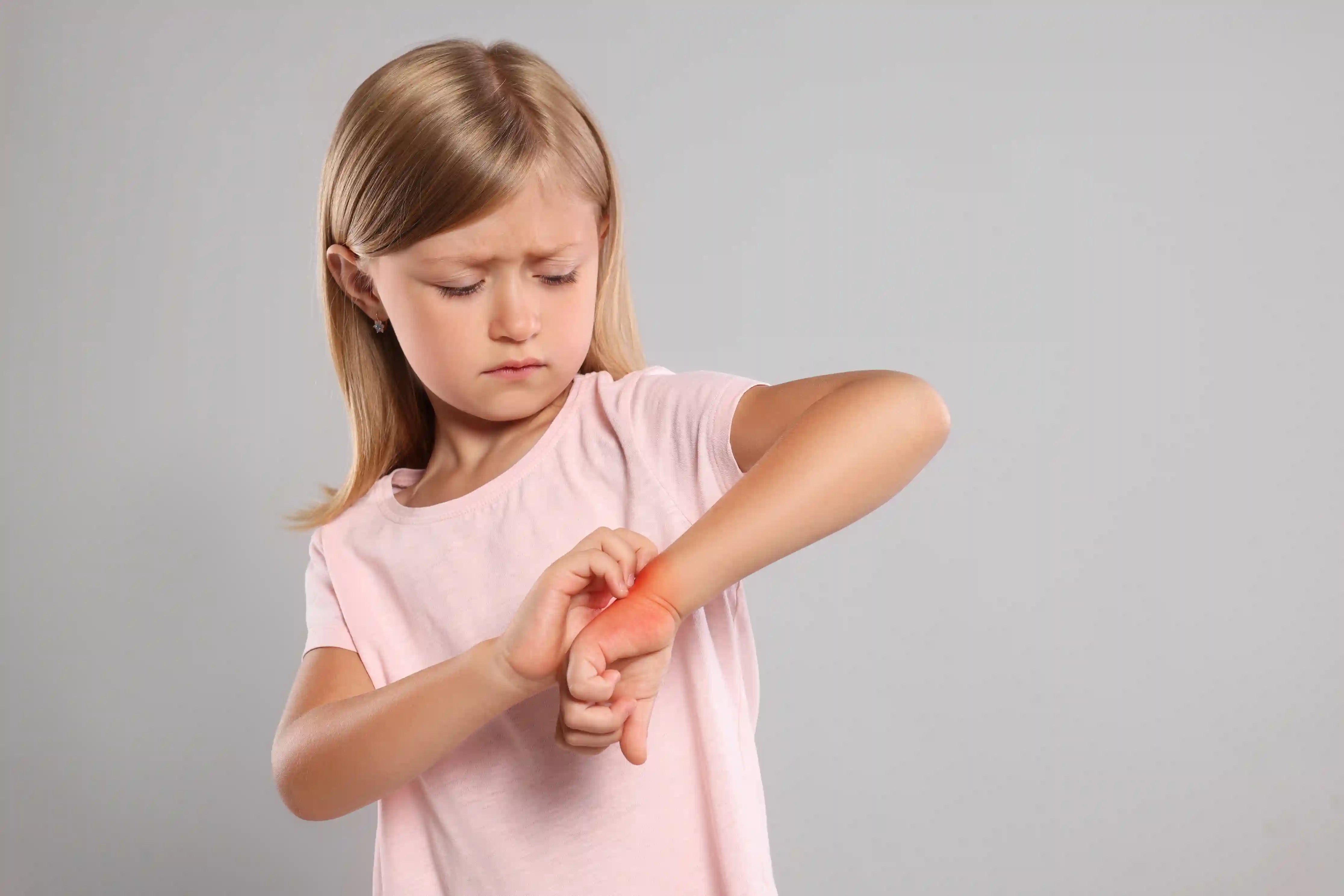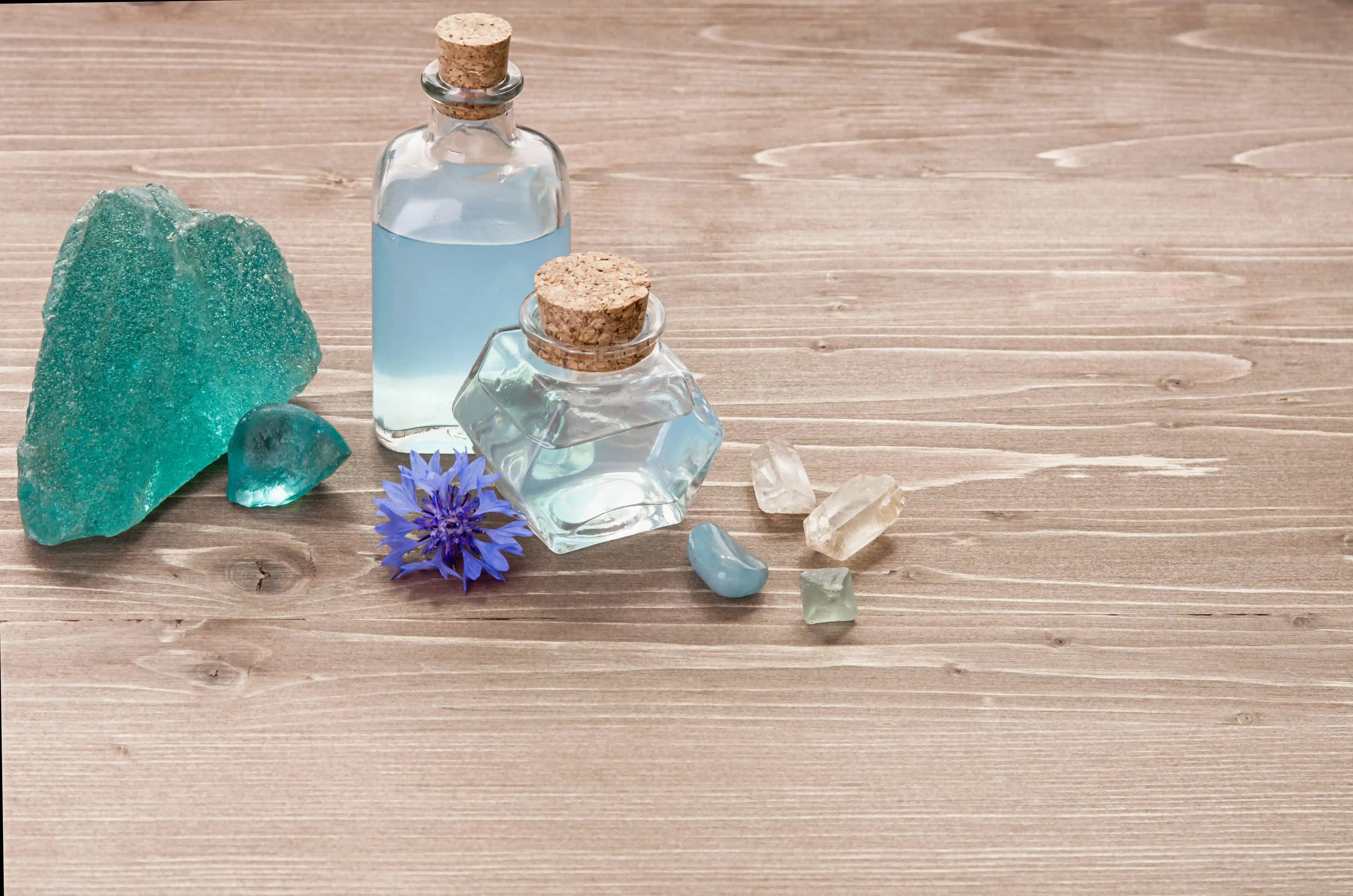Bullous eczema, also known as dyshidrosis or pompholyx eczema, is a specific and often painful skin condition that primarily affects the hands and feet. This condition manifests as small, fluid-filled blisters or vesicles, accompanied by intense itching and inflammation of the skin.
If you have observed such symptoms on your child's hands or feet, it is essential to understand the mechanisms of bullous eczema, its causes, symptoms, as well as ways to relieve and prevent it.
In this article, we'll cover the different facets of bullous eczema , from its definition and symptoms to treatments and everyday actions to prevent flare-ups. Whether you're dealing with this condition or want to help a loved one, the following information will help you better understand and manage this often uncomfortable skin condition.
What is bullous eczema?
Definition of bullous eczema or vesicular dyshidrosis
Bullous eczema, also known as dyshidrosis or pompholyx, is a specific form of eczema characterized by the appearance of small vesicles or blisters filled with clear fluid. These vesicles are located mainly on the palms of the hands, the soles of the feet, as well as on the lateral surfaces of the fingers and toes.
This skin disease often manifests in outbreaks, with vesicles that can develop into larger bullae if they confluence. The affected areas usually appear red , inflamed, and are accompanied by intense itching. The evolution of these vesicles includes their drying, a yellowish discoloration, and fine scaling once they disappear.
Differences from other types of eczema
Bullous eczema is distinguished from other forms of eczema by its specific location on the hands and feet . While other types of eczema can affect various parts of the body, dyshidrosis is exclusive to the areas mentioned above, making it easier to identify.
Additionally, dyshidrosis is often associated with specific factors such as excessive sweating, certain contact allergies, and stress, which differentiates it from other forms of eczema with varied causes and triggers.
What are the symptoms of bullous eczema?
Blisters and vesicles: characteristic signs
The most visible symptoms of bullous eczema include the appearance of small vesicles or blisters filled with clear or citrus-like fluid. These vesicles may form in isolation or coalesce to form larger bullae.
Mainly located on the palms of the hands, the soles of the feet, as well as on the lateral surfaces of the fingers and toes, these vesicles are a key indicator of this condition.
Intense itching and peeling of the skin
The blisters and blisters associated with bullous eczema often cause intense itching and burning sensations. This itching can lead to incessant scratching, worsening the skin condition .
When the blisters dry, they have a yellowish tint and are followed by fine peeling of the skin.
Frequent locations: hands, fingers, feet, sometimes the face
Although bullous eczema mainly affects the hands and feet, it can exceptionally affect other areas , such as the face. The palms of the hands and soles of the feet remain the most commonly affected sites, with vesicles also forming on the lateral edges of the fingers and toes.
Evolution into flare-ups and chronic aspect in some children
Bullous eczema typically progresses in flare-ups, interspersed with periods of remission. These flare-ups can occur at any time, with an increased incidence in spring and summer. In some children, this condition can become chronic, requiring ongoing management and tailored care.
What are the possible causes of bullous eczema?
Contact allergies (nickel, soaps, detergents, etc.)
One of the main causes of bullous eczema is often linked to contact allergies. Exposure to certain substances such as nickel, cobalt, chromium , or even household products like soaps and detergents , can trigger this skin condition.
Women are particularly susceptible to developing this condition due to their frequent exposure to antigens found in jewelry or cosmetics.
Stress, anxiety and emotional fatigue
Stress, anxiety, and emotional exhaustion are also significant triggers of bullous eczema. Periods of emotional stress can exacerbate symptoms and trigger new flare-ups, highlighting the importance of managing mental well-being to control this condition.
Excessive sweating and humidity
Excessive sweating and humidity contribute to the onset and worsening of bullous eczema. The hands and feet , being the most affected areas, are particularly sensitive to sweating and humidity, which can intensify symptoms, especially during hot and humid times of the year .
Genetic predisposition and atopic terrain
Certain genetic predispositions may increase susceptibility to bullous eczema. Studies suggest that specific genetic mutations may play a role in this vulnerability.
Additionally, individuals with a history of atopic conditions, such as atopic eczema or allergic rhinitis, are more prone to developing bullous eczema.
How to relieve bullous eczema in children?
Soothe itching without damaging the skin
To relieve the intense itching associated with bullous eczema in a child, it is important to limit scratching so as not to aggravate the condition. Always keep nails short, smooth, and clean to avoid further irritation .
Applying cold or wet compresses to the affected areas can help soothe itching and reduce burning sensations.
Hydrate and strengthen the skin barrier daily
Skin hydration is essential in managing bullous eczema. Use mild, non-irritating soaps when washing hands and feet, and choose lukewarm water for showers or baths. Gently pat wet skin dry with a soft towel, then generously apply a suitable moisturizer , such as Doucéa APAISÉA Cream , to seal in moisture and help soothe the skin.
Choose care products suitable for sensitive and reactive skin
It is essential to select skincare products specifically formulated for sensitive and reactive skin. Opt for hypoallergenic creams and lotions , such as Doucéa's DOUTOPIA Cream , designed for atopic-prone skin, to strengthen the skin barrier and prevent further irritation.
Use of emollient or soothing creams
Emollient and soothing creams play a key role in managing bullous eczema. A corticosteroid cream, prescribed by a dermatologist, may be necessary to reduce inflammation and soothe itching.
These creams should be applied regularly , especially after washing or showering, to maintain skin hydration and protection.
Preventing bullous eczema flare-ups: everyday actions and reflexes
Preventing bullous eczema attacks and limiting their intensity requires the adoption of several daily actions and reflexes.
First, avoid contact with irritants . Wear cotton gloves or special protective gloves when handling substances that can trigger an attack, such as harsh soaps, detergents, or metals like nickel.
Maintain good hand and foot hygiene by drying them gently after each contact with water to avoid maceration of the skin, which can aggravate symptoms.
Changing socks and intimate clothing daily also helps maintain healthy skin and prevent excessive moisture.
Clothing choices play an important role in preventing flare-ups. Choose clothing made from natural materials, such as cotton , over synthetic fibers, especially during hot and humid times of the year. This helps reduce perspiration and keeps skin drier and less irritated.
Since stress is a major trigger, adopting relaxation techniques, such as meditation or deep breathing exercises, can help manage stress and prevent flare-ups. Additionally, avoiding smoking is strongly recommended, as tobacco can exacerbate the symptoms of bullous eczema.
Finally, avoid bursting blisters or blisters, as this can lead to infection and worsen the condition. If itching is severe, apply cool, wet compresses to soothe the skin and reduce burning sensations.
When should you consult a healthcare professional?
It is essential to consult a healthcare professional, particularly a dermatologist, as soon as the first symptoms of bullous eczema appear. This consultation allows for a diagnosis to be confirmed and a treatment plan to be put in place that is tailored to your specific situation.
When bullous eczema is suspected, the dermatologist will ask several questions about potential triggers of the skin condition and perform a careful examination of the affected areas. A differential diagnosis is often necessary to distinguish dyshidrosis from other skin diseases with similar symptoms, such as psoriasis, allergic contact dermatitis, or even scabies.
If the diagnosis of bullous eczema is confirmed, the dermatologist may order additional skin tests, such as patch tests, to identify irritants responsible for flare-ups. These tests help determine specific allergens to avoid to prevent future flare-ups.
Additionally, if the itching is very intense and affects social life, psychological support may be recommended. Since stress and anxiety are potential triggers, managing these emotional aspects is important for better disease management.
Finally, in case of infection of the blisters or vesicles, it is imperative to consult a health professional immediately to avoid any complications and receive appropriate treatment.
Conclusion
Bullous eczema, or dyshidrosis, is a skin condition characterized by the appearance of blisters and intense itching, mainly on the hands and feet. To manage this condition, it is essential to understand its symptoms and causes, and to adopt daily preventive measures. Avoid irritating substances, regularly moisturize the skin with suitable products such as Doucéa creams , and consult a dermatologist for proper diagnosis and treatment. Don't neglect the emotional aspects and take care of your overall well-being.
By following these recommendations, you can relieve symptoms and significantly improve your child's quality of life.
Don't hesitate to act at the first sign to prevent complications and restore healthy, soothed skin. Take care of yourself and your skin, and consult a healthcare professional if necessary.
















